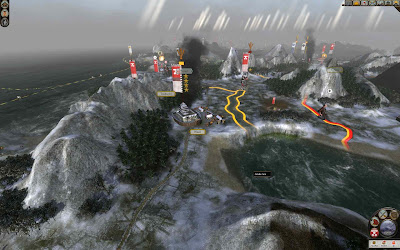Hagi Castle fell to the Mori in summer 1564 with the help of the Kikkawa. The loss of their capital was a major blow to the Ouchi, but the losses sustained by Mori Takamoto's army was so great that he was forced to call a halt to offensive operations in order to replenish his army. During that pause the Kikkawa stole a march on the Mori and annexed Suo. They then moved swiftly, crossed the Kanmon strait between Honshu and Kyushu, and annexed Buzen, famous for its archers (Buzen formerly belonged to the Mori and previously to that the now extinct Shoni).
Mori Takamoto could not shake off the suspicion that, during the storming of Hagi Castle, the Kikkawa had deliberately held back their army so that the Mori would suffer high casualties, thus allowing them to advance ahead of the Mori. Although the Mori were not pleased with the Kikkawa's land grabbing, they could not afterall begrudge the Kikkawa their gains after receiving their help in the conquest of Nagato. Further, the Kikkawa conquests helped to weaken the Ouchi in the interim while the Mori rested their army.
The Mori navy in the meantime swept regional waters clear of Ouchi vessels and established naval superiority around the Kanmon strait paving the way for the crossing. The Ouchi navy consisted of relatively many Sengoku Bunes but they do not appear to understand the value of concentrating their fleets and so were easily destroyed piecemeal. However, a medium sized fleet managed to chase away the Mori cotton trade fleets and smaller fleets also caused temporary nuisance by blockading Mori ports.
In time, the Mori were ready to resume the offensive. Mori Takamoto crossed the Kanmon strait with his army into Kikkawa held Buzen and then proceeded on to Tsukushi easily occupying Fukuoka Castle encountering little or no resistance in the process. The was no sign of the Ouchi army.
They pressed further into Hizen and conquered the fortress of Dazaifu. Again there was no sign of the Ouchi army.
After the fall of Hizen, Mori Sanemune moved quickly to occupy the strategic river crossing on the Fukuoka-Kunamoto road. A medium sized Ouchi army was detected in Kunamoto Castle in Higo province.
The Ouchi appear to have divided their forces into three parts.
One part invaded Bungo province, but found Funai castle too well defended and so attacked and damaged the port instead. Encamped in the field in enemy territory in the middle of winter, they suffer attrition and also face a large Kikkawa army bearing down on them.
Another part invaded Osumi province in eastern Kyushu, but the defenders of Kanoya Castle put up a valiant defence and defeated the besieging army. Having understood the value of archers in attacking and defending castles, the Mori had recruited many companies of archers in Osumi and made good use of them in the battle.
The third part was in Higo province. Once Hizen is pacified, Mori Takamoto will consolidate his army and advance into Higo.
Attack on Funai Castle
In winter 1565, the writing was on the wall for the Ouchi, but they decide to make one last futile attack on Funai Castle in Bungo. The Ouchi attack with their army in Kunamoto Castle leaving it undefended. The attack is entirely pointless as the defenders outnumber the attackers.
What the defenders lack in quality they more than make up for in numbers and positional superiority, and the attackers are easily beaten back.
In so wasting their army, the Ouchi have left Kunamoto completely undefended and the Mori expect to take it easily in the following season.







No comments:
Post a Comment